About Thessaloniki
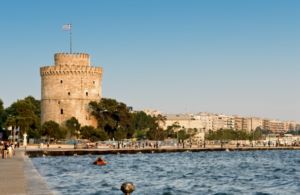 Thessaloniki, Greece’s second largest city, holds an uninterrupted history of 2,300 years. Named after the sister of Alexander the Great, the city was founded as the major port of the Macedonian kingdom. It was the historic meeting point of five different cultures: the Hellenistic, Roman, Byzantine, Ottoman and Jewish, which despite some turbulent encounters merged and flourished peacefully, creating a truly cosmopolitan city in South East Europe, with a population today of more than one million people.
Thessaloniki, Greece’s second largest city, holds an uninterrupted history of 2,300 years. Named after the sister of Alexander the Great, the city was founded as the major port of the Macedonian kingdom. It was the historic meeting point of five different cultures: the Hellenistic, Roman, Byzantine, Ottoman and Jewish, which despite some turbulent encounters merged and flourished peacefully, creating a truly cosmopolitan city in South East Europe, with a population today of more than one million people.
The second largest city of Greece, Thessaloniki is famous for its lively streets, vibrant night life and cultural signature. It is the perfect cosmopolitan destination for any visitor.
Thessaloniki also has a mystical atmosphere, emphasized by the enduring symbols of its long history, from the White Tower on its cafe-lined waterfront all the way up to the Byzantine walls, just above Ano Poli (the Upper Town), an enchanting neighbourhood of pretty traditional houses set on winding, peaceful alleyways.
Commercial and Business Centre
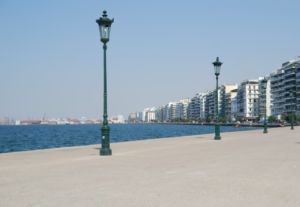
The city boasts a busy commercial port, which functions as a gateway to SE Europe for cargo from the Far East. Thessaloniki plays an important role and has a special interest in the Balkan, European and wider international area. The city’s key position is also reinforced by its hosting several international economic and political institutions, such as the Black Sea Trade and Development Bank (BSTDB), the European Centre for the Development of Vocational Training (CEDEFOP), the Office for the Stability Pact for SE Europe, the Institute for Balkan Studies (IMXA), and the Centre of International and European Economic Law (CIEEL).
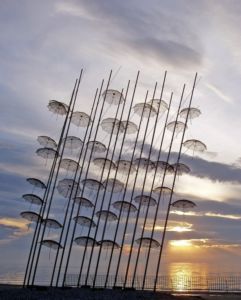
The city is also home to the Centre for Democracy and Reconciliation in SE Europe (CDRSEE), the European Centre for Information to Enterprises as well as the UNESCO Centre for Women and Peace in the Balkans (UNES Centre). The annual International Fair is a well established highlight of the City’s commercial activities.
Explore Thessaloniki
A brief video highlighting the city’s most iconic spots
Places of interest
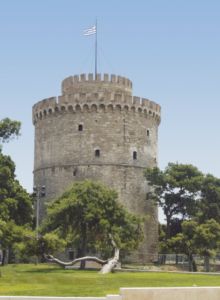 The White Tower
The White Tower
A beautifully built, round fort on the eastern waterfront. It was built in the 15th century as part of the city’s seafortifications and it has become the most recognised landmark of Thessaloniki. During the Ottoman occupation it became a symbol of terror because of the gruesome executions of prisoners that took place there. After the city’s liberation in 1912, the tower was whitewashed as if to purify it from the blood with which it was so often stained, hence the name “White Tower”. The Tower houses the “Museum of History and Art of Thessaloniki”.
The Rotunda
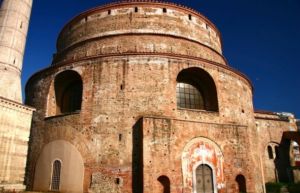 A circular building erected in A.D. 306 as the Pantheon or Mausoleum of the Roman Emperor Galerius. Under Theodosius the Great, it became a Christian church with only a few additions and alterations. Its mosaics are unique for the era (4th century). A minaret is preserved from its subsequent use as a mosque in the period from 1590-1912 under Ottoman rule. Located on Dimitriou Gounari Street, the Rotunda and the sculpted Arch of Galerius in Kamara Square are two of the most recognisable sights of the city. Just across the street, Navarino Square displays the remains of the city’s ancient market.
A circular building erected in A.D. 306 as the Pantheon or Mausoleum of the Roman Emperor Galerius. Under Theodosius the Great, it became a Christian church with only a few additions and alterations. Its mosaics are unique for the era (4th century). A minaret is preserved from its subsequent use as a mosque in the period from 1590-1912 under Ottoman rule. Located on Dimitriou Gounari Street, the Rotunda and the sculpted Arch of Galerius in Kamara Square are two of the most recognisable sights of the city. Just across the street, Navarino Square displays the remains of the city’s ancient market.
The Church of Saint Demetrios
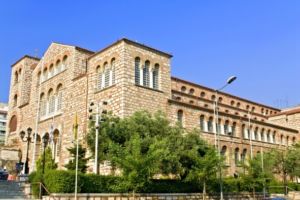 The Church of Saint Demetrios is a five-aisled basilica, with a narthex and a transept. Under the sanctuary and the transept there is the crypt. The chapel of Saint Euthymios is attached to the south-east corner of the church. Very few fragments of the sculptural and pictorial decoraration (mosaics, wall paintings) of the church survived the disastrous fire of 1917 but they are representative of the successive phases of the monument’s history.
The Church of Saint Demetrios is a five-aisled basilica, with a narthex and a transept. Under the sanctuary and the transept there is the crypt. The chapel of Saint Euthymios is attached to the south-east corner of the church. Very few fragments of the sculptural and pictorial decoraration (mosaics, wall paintings) of the church survived the disastrous fire of 1917 but they are representative of the successive phases of the monument’s history.
The Old Town or Upper Town
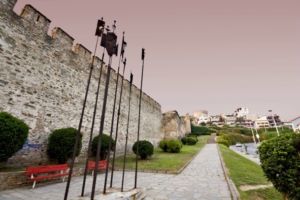 The Old Town boasts many of Thessaloniki’s tourist attractions, particularly some of its oldest Byzantine churches and buildings. You can catch glimpses of what “Old Salonica” must have been like in the walled Kastra quarter of the city, on the hillside above the modern grid of streets.
The Old Town boasts many of Thessaloniki’s tourist attractions, particularly some of its oldest Byzantine churches and buildings. You can catch glimpses of what “Old Salonica” must have been like in the walled Kastra quarter of the city, on the hillside above the modern grid of streets.
MUSEUMS
Archaeological Museum of Thessaloniki
A museum well worth visiting, the Archaeological Museum of Thessaloniki houses art from Archaic, Classical and Hellenistic eras, as well as artefacts from Ancient Macedonia including gold ornamental art and ancient Greek weapons. (Plateia HANTH)
Museum of Byzantine Culture
An award-winning museum, the architecture harks back to enclosed Byzantine courtyards. The museum’s exhibits illustrate Byzantine history and culture through icons, art and every day artefacts.
(2 Stratou Street)
Other important museums of Thessaloniki include the following:
- Museum of the Macedonian Struggle
- Thessaloniki History Centre
- Folklife and Ethnological Museum of Macedonia and Thrace
- Museum of the Jewish Presence in Thessaloniki
- State Museum of Contemporary Art
- Macedonian Museum of Contemporary Art
- Museum of History and Art of Thessaloniki (the White Tower)
- Thessaloniki Cinema Museum
- Museum of Ancient Greek, Byzantine and Post-Byzantine Musical Instruments
- Thessaloniki Science Centre and Technology Museum
Archaeological spots
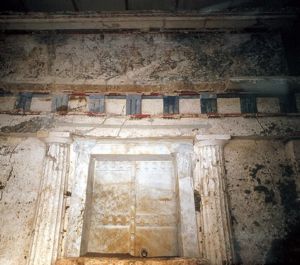 Vergina, a village located in the Prefecture of Imathia, about 80 km south-west of Thessaloniki, is identified with the ancient town of Aigai, the first capital of ancient Macedonia. Today one can visit the ancient royal palace and the theatre of the town, as well as the Great Tumulus with the royal tombs, one of which is claimed to be the tomb of Philip II, the father of Alexander the Great. The tumulus is incorporated in the archaeological museum of Vergina, which was built in a way to protect the tombs, exhibit the artifacts and show the tumulus as it was before the excavations. Among the finds exhibited are golden, silver and ivory objects, utensils and armory. One can also see the impressive facades of the so-called Macedonian Tombs, decorated with wall paintings.
Vergina, a village located in the Prefecture of Imathia, about 80 km south-west of Thessaloniki, is identified with the ancient town of Aigai, the first capital of ancient Macedonia. Today one can visit the ancient royal palace and the theatre of the town, as well as the Great Tumulus with the royal tombs, one of which is claimed to be the tomb of Philip II, the father of Alexander the Great. The tumulus is incorporated in the archaeological museum of Vergina, which was built in a way to protect the tombs, exhibit the artifacts and show the tumulus as it was before the excavations. Among the finds exhibited are golden, silver and ivory objects, utensils and armory. One can also see the impressive facades of the so-called Macedonian Tombs, decorated with wall paintings.
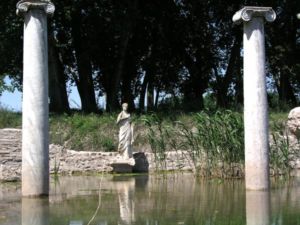 About an hour (85 km) to the SW of Thessaloniki, in the Prefecture of Pieria, you can find the ancient town of Dion, at the foot of Mt.Olympus. Dion provides an impressive archaeological site in a landscape of extraordinary beauty. It is the town where Zeus (Δίας) was honoured, from whom it took its name. There was a large temple dedicated to him, as well as temples dedicated to other deities, such as Demeter, Asklepios and Isis. Apart from the temples one can see the walls of the city, a Hellenistic and a roman theatre, the odeion, the public baths, workshops, houses of rich citizens with mosaic floors and two early Christian basilicas. You can also visit the Archaeological Museum, one of the best in Northern Greece , with hundreds of exhibits, including the famous hydraulis, a unique musical instrument, the ancestor of the modern church organ.
About an hour (85 km) to the SW of Thessaloniki, in the Prefecture of Pieria, you can find the ancient town of Dion, at the foot of Mt.Olympus. Dion provides an impressive archaeological site in a landscape of extraordinary beauty. It is the town where Zeus (Δίας) was honoured, from whom it took its name. There was a large temple dedicated to him, as well as temples dedicated to other deities, such as Demeter, Asklepios and Isis. Apart from the temples one can see the walls of the city, a Hellenistic and a roman theatre, the odeion, the public baths, workshops, houses of rich citizens with mosaic floors and two early Christian basilicas. You can also visit the Archaeological Museum, one of the best in Northern Greece , with hundreds of exhibits, including the famous hydraulis, a unique musical instrument, the ancestor of the modern church organ.
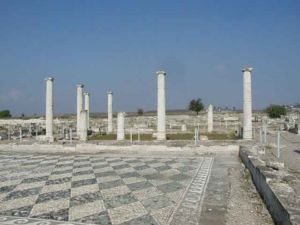 Pella, an ancient city located in the homonymous Prefecture, less than an hour to the west of Thessaloniki (about 40 km), was founded by the Macedonian king Archelaus as the capital of his kingdom, replacing the older palace-city of Aigai (Vergina). It was the seat of the king Philip II and Alexander the Great. Archaeological excavations have uncovered a small part of the city that was designed on the famous “hippodamean” plan, which forms a grid of eight rows of rectangular blocks. One can see today the walls, the palace, the large agora (market) surrounded by porticos on all four sides, temples dedicated to Aphrodite, Cybele and Darron, private houses, the thesmophoreion and the cemetery. Pella is famous for its mosaic floors, e.g. the Lion Hunt Mosaic, most of which are exhibited in the Archaeological Museum of Pella .
Pella, an ancient city located in the homonymous Prefecture, less than an hour to the west of Thessaloniki (about 40 km), was founded by the Macedonian king Archelaus as the capital of his kingdom, replacing the older palace-city of Aigai (Vergina). It was the seat of the king Philip II and Alexander the Great. Archaeological excavations have uncovered a small part of the city that was designed on the famous “hippodamean” plan, which forms a grid of eight rows of rectangular blocks. One can see today the walls, the palace, the large agora (market) surrounded by porticos on all four sides, temples dedicated to Aphrodite, Cybele and Darron, private houses, the thesmophoreion and the cemetery. Pella is famous for its mosaic floors, e.g. the Lion Hunt Mosaic, most of which are exhibited in the Archaeological Museum of Pella .
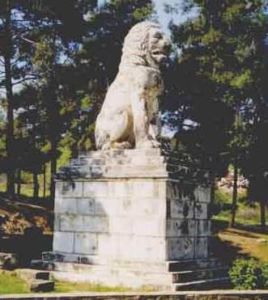 Amphipolis, an ancient city in the Serres Prefecture , is situated about 98 km to the east of Thessaloniki . It was founded in 437 BC by the Athenians on a raised plateau overlooking the east bank of the Strymon River . Excavations have uncovered remains at the site dating to approximately 3000 BC. Due to its strategic location the city was fortified very early. In 357 BC Philip II conquered the town, which became an important naval base during the reign of Alexander. Today, visitors to the site can see part of the fortification of the city, the gymnasium, private houses and early Christian basilicas. However, the most famous monument of the region is the “Amphipolis Lion”, a marble and probably funerary monument of the 4th century BC. Amphipolis has also a very interesting Archaeological Museum, which contains many items related to the history and civilisation of the site, dating from prehistoric times down to the Byzantine period.
Amphipolis, an ancient city in the Serres Prefecture , is situated about 98 km to the east of Thessaloniki . It was founded in 437 BC by the Athenians on a raised plateau overlooking the east bank of the Strymon River . Excavations have uncovered remains at the site dating to approximately 3000 BC. Due to its strategic location the city was fortified very early. In 357 BC Philip II conquered the town, which became an important naval base during the reign of Alexander. Today, visitors to the site can see part of the fortification of the city, the gymnasium, private houses and early Christian basilicas. However, the most famous monument of the region is the “Amphipolis Lion”, a marble and probably funerary monument of the 4th century BC. Amphipolis has also a very interesting Archaeological Museum, which contains many items related to the history and civilisation of the site, dating from prehistoric times down to the Byzantine period.
Nightlife
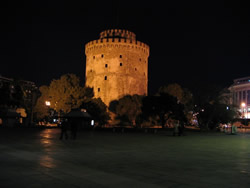 Thessaloniki offers all kinds of entertainment and is renowned for its good food and “mezedes” (dishes of food accompanying drinks).
Thessaloniki offers all kinds of entertainment and is renowned for its good food and “mezedes” (dishes of food accompanying drinks).
The youthful spirit of the city, which hosts many elegant restaurants and a multitude of “ouzeries” and taverns, is to be found both in the city and the suburbs. The student community of some 60,000 contributes to the creation of a very vivid and vibrant atmosphere. The waterfront cafes of Leoforos Nikis and the bars of the city centre district are among the main poles of attraction. Among the most popular areas to drink a coffee or a beer are:
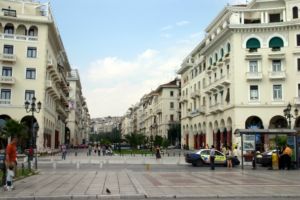 Aristotle Square (Aristotelous)
Aristotle Square (Aristotelous)
The most popular tourist cafes and bars lie round the central square of the city and street of the same name. One can find quiet cafes or noisy ones, according to your preferences.
Proxenou Koromila Street
Parallel to Nikis Avenue is Pr. Koromila Street with various cafes and bars.
Iktinou pedestrian precinct
Another place in the city with cafes and bars and a couple of restaurants
Ladadika district
On the west side of the centre lies the picturesque neighbourhood of Ladadika, named after the many stores that used to sell the oil (ladi) arriving from the adjacent harbour. Formerly a somewhat notorious district, the Ladadika has since been renovated and its many stone-built warehouses now host some of the most well-known bars and nightclubs, covering all sorts of music, including traditional Greek bouzoukia.
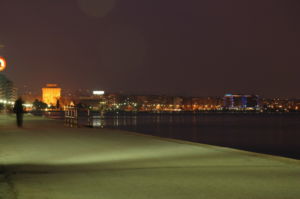 Nikis Avenue
Nikis Avenue
The seafront avenue is full of cafeterias usually crowded around the clock, available for coffee in the daytime and beer or drinks at night.
Athonos Square
Preferred by many students of the city, Athonos Square is full of simple Greek taverns serving meat and/or fish dishes accompanied by wine, retsina (traditional low cost wine), beer and ouzo. Some feature live Greek music.
Bit Bazaar (flea market)
This area is another lively (and noisy) student hang-out with bars and ouzeries that fills up on warm nights.
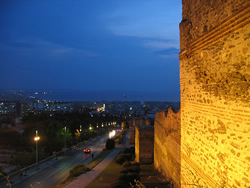 Kastra (Ano Poli)
Kastra (Ano Poli)
Up the hill, next to the Byzantine walls, you can find many good restaurants with views over the city.
Tsinari
An old district in Ano Poli hosting the tavern of the same name, along with many others.
Aretsou
Aretsou lies to the east and is part of the suburb of Nea Krini after that of Kalamaria. Along Plastira Avenue running close to the sea front, one can find family coffee shops which transform into bars at night, booming with vibrant music and crowded with young patrons.
Weekend Getaways
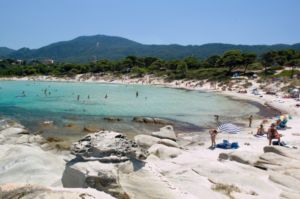 Halkidiki
Halkidiki
The beautiful triple peninsula of Halkidiki to the south-east of Thessaloniki is a popular tourist destination. Every corner of Halkidiki is a paradise on earth, with sunny, golden beaches, picturesque bays and many traditional villages.
Halkidiki has the longest coastline on mainland Greece relative to land area. Its winding coast creates a lacework of superb beaches and tiny coves, with olive groves and pine forests dropping down to the very edge of the crystal-clear water.
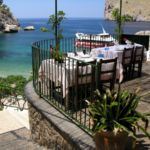 The Kassandra peninsula is about 1-1.5 hours away from Thessaloniki and its beaches are a favourite destination. From picturesque villages such as Athitos to cosmopolitan meeting places such as Kallithea, Hanioti and Fourka, this part of Halkidiki can satisfy the most demanding visitor.
The Kassandra peninsula is about 1-1.5 hours away from Thessaloniki and its beaches are a favourite destination. From picturesque villages such as Athitos to cosmopolitan meeting places such as Kallithea, Hanioti and Fourka, this part of Halkidiki can satisfy the most demanding visitor.
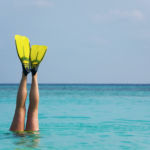 The Sythonian peninsula is about 1.5-2 hours away from Thessaloniki and is home to green pine forests. Also famous for its alternative tourism, Halkidiki’s second peninsula offers numerous camping sites and sandy beaches to match everyone’s desires.
The Sythonian peninsula is about 1.5-2 hours away from Thessaloniki and is home to green pine forests. Also famous for its alternative tourism, Halkidiki’s second peninsula offers numerous camping sites and sandy beaches to match everyone’s desires.
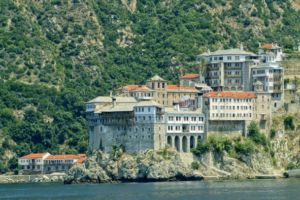 Mt. Athos (Agio Oros)
Mt. Athos (Agio Oros)
The eastern peninsula of Halkidiki is in effect an autonomous religious community where a host of Christian Orthodox monasteries, rich in both architecture and works of art, are perched high upon its spectacular cliffs. The splendour of its unspoilt natural beauty is also incomparable.
Only male visitors are allowed on Mt. Athos. An entry permit (diamonitirion) must be obtained from the Pilgrims Office in Thessaloniki (tel. 2310 252578, 252575) allowing a stay of up to four nights as guests at the monasteries. As the number of visitors is restricted, it is advised that places are booked well in advance (e.g., six months ahead).
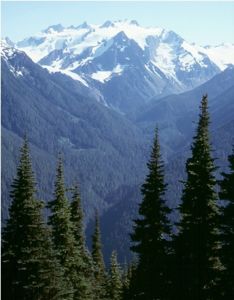 Hiking
Hiking
Mighty Mount Olympus was the heavenly home of the gods in ancient times and still inspires thousands of visitors who come from all over the world to tackle the tough trek to the highest peak in Greece. The entire area was declared Greece’s first national park in 1937 and consists of eight peaks including the “Throne of Zeus” at 2909 metres and Mytikas which has the highest summit at 2919 metres. Special climbing experience is not demanded to take on Olympus but one needs to be fit and properly equipped.
The park is located 100 kilometres to the south west of Thessaloniki. The main base for hikers is the village of Litohoro, nestling on the coastal slopes of the mountain. There are three mountain refuges that provide welcome overnight pit stops for tired hikers.
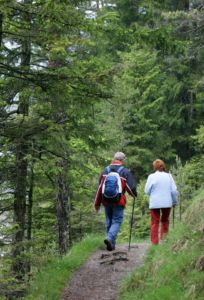 This magnificent mountain range is home to around 1700 plant species, many of which are unique to Olympus. The mountainsides are cloaked in dense forests of pine, beech, oak and cedar trees, which harbour various wildlife including wolves, bears and lynx. The slopes are buried beneath two metres of snow in winter and only accessible to the most experienced climbers – even in July the snow lurks in shadowed corners and crevices.
This magnificent mountain range is home to around 1700 plant species, many of which are unique to Olympus. The mountainsides are cloaked in dense forests of pine, beech, oak and cedar trees, which harbour various wildlife including wolves, bears and lynx. The slopes are buried beneath two metres of snow in winter and only accessible to the most experienced climbers – even in July the snow lurks in shadowed corners and crevices.
While you’re in the area, take the time to visit ancient Dion at the foot of Mt Olympus, just north of Litohoro. New discoveries are still being made at this fascinating archaeological site where sacred sanctuaries of the gods, superb mosaics, an ancient theatre and a vast public bath complex have been uncovered. Musical and theatrical performances are held in the restored theatre every August during the Festival of Olympus.
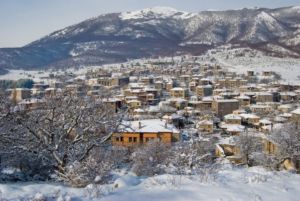 Winter excursions – Skiing
Winter excursions – Skiing
Unknown perhaps to foreigners visiting Greece, many alternatives are available for weekend excursions during the winter, including a number of good ski centres. Picturesque villages are reached with a 1-2 hour drive. The old village of Aghios Athanasios is situated at the west end of the prefecture of Pella, on the borders with the prefecture of Florina and very close to Vegoritida Lake. The village dates back to the late 16th century and impresses tourists with its traditional colour and architecture.
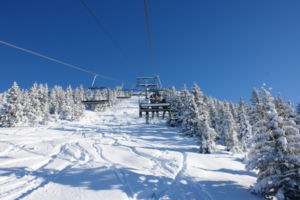 For ski fans the ski resort of Kaimaktsalan lies close by. It is built at an altitude of 1,200 m. With a longer snow coverage period than other mountains, it is in operation from the end of November till the start of May. It lies at a height of about 2050 metres with the ski slopes reaching up to 2480 metres. There are 14 ski trails, of different levels of difficulty, one of which is the only one in Greece that is of Olympic proportions. There is also a ski trail for snowmobiles and a snowboard fun-park for the fanatics.
For ski fans the ski resort of Kaimaktsalan lies close by. It is built at an altitude of 1,200 m. With a longer snow coverage period than other mountains, it is in operation from the end of November till the start of May. It lies at a height of about 2050 metres with the ski slopes reaching up to 2480 metres. There are 14 ski trails, of different levels of difficulty, one of which is the only one in Greece that is of Olympic proportions. There is also a ski trail for snowmobiles and a snowboard fun-park for the fanatics.
Other options offered for ski fans are the ski resorts of Seli and 3-5 Pigadia nearby at Naoussa, a 1.5-2 hours drive from Thessaloniki, as well as others further away at Pisoderi near Florina and Falakro close to Drama.
